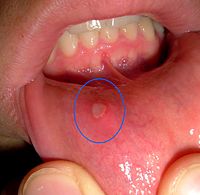
Photo from wikipedia
Primary burning mouth syndrome is a term used for chronic oral mucosal pain with no identifiable organic cause. The aim of the study was to evaluate the usefulness of a… Click to show full abstract
Primary burning mouth syndrome is a term used for chronic oral mucosal pain with no identifiable organic cause. The aim of the study was to evaluate the usefulness of a psychiatric intervention for treating burning mouth syndrome based on a joint consultation with a psychiatrist and a dermatologist. The study was proposed to all patients who visited this consultation group between 2001 and 2017 for the treatment of primary burning mouth syndrome. The patients answered a questionnaire that was administered via mail. Of the 57 patients diagnosed with primary burning mouth syndrome, 38 were included. Seven patients (18.4%) no longer had pain; 8 (21.1%) estimated that the pain had decreased by greater than 50%; 11 (28.9%) estimated the decrease at between 30 and 50%, and 12 (31.6%) estimated a less than 30% decrease. Only 14 patients (36.8%) remained under treatment with antidepressants, as compared to 63.2% before the psychiatric intervention. This psychiatric intervention could be considered a valuable tool in the global burning mouth syndrome treatment strategy.
Journal Title: Acta dermato-venereologica
Year Published: 2018
Link to full text (if available)
Share on Social Media: Sign Up to like & get
recommendations!